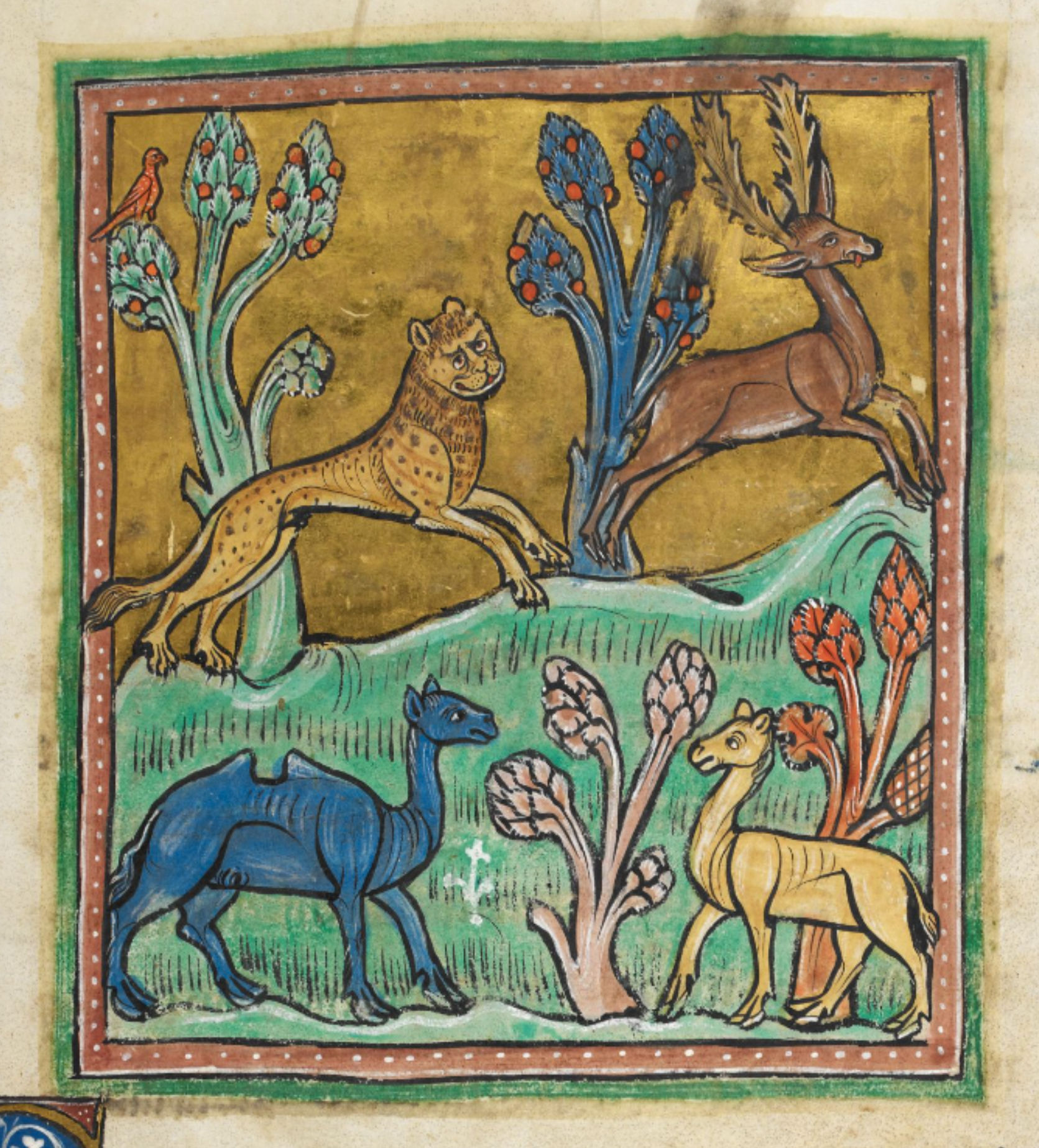Leopard, Rochester Bestiary, c.1230
The word leopard comes from Late Latin leopardus, leo is lion and pardus the panther due to their crossbreeding. The Romans imported this beast to Europe in order to use it in amphitheatres, particularly in the venationes games, which involved the hunt and killing of wild animals and during death sentences, damnatio ad bestias, where prisoners were devoured by these wild beasts.
Leopards are mentioned by Pliny the Elder in his Naturalis Historia (Natural History) and also by Isidore of Seville in his Etymologies1, describing the leopard as “having mottled coat, speckled with white like a giraffe’s. Swift and headlong for blood, they kill their prey with a single leap”.
In Latin Literature, Virgil mentioned the leopard in The Aeneid (Book VII, lines 348-349): "Next came the spotted leopard, here displayed, / And great with young a Tyrian huntress led”. Virgil describes a leopard being led by a Tyrian2 huntress in the context of a description of a parade or procession.
In Medieval Christian religion, the leopard acquires a demonic reputation. Apparently, the Antichrist is supposed to resemble a pard. In Revelations 13:2, John describes the beast from the sea as resembling a leopard: “And the beast that I saw was like a leopard; its feet were like a bear’s, and its mouth was like a lion’s mouth. And to it the dragon gave his power and his throne and great authority”.
ad sanguinem. Saltu enim ad mortem ruit. Pardus
ex adulterio leene nascitur et pardi. et terciam origi-
nem efficit. Sicut et plinius in naturali historia dicit.
leonem cum parda aut pardum cum leena concum-
bere. Et ex utroque coitu degeneres partus creari. Ut mu-
lus et burdo3
The leopard is a species with mottled skin: it is extremely swift and longs for blood, for it kills its prey with one leap. The leopard is born from the adulterous crossbreeding of a lioness and a panther, creating a third species. As Pliny4 states in his Natural History, a lion with a female panther or a panther with a lioness can copulate. From both unions, degenerate offspring are begot. Such is the example of a mule and a hinny.
Further Reading
David Badke, The Bestiary Blog: Animals in the Middle Ages, Leopard, November 6 2023, https://bestiary.ca/beasts/beast547.htm
Josh Goldenberg (BA 2012) and Matt Shanahan (BA 2014, Logeion, November 2022, https://logeion.uchicago.edu/
Castiglioni, L. and Mariotti, S. (1996). Vocabolario della Lingua Latina: Latino-Italiano Italiano-Latino. Terza Edizione. Loescher Torino
Matthews, J. and Matthews C., (2010), The Element Encyclopedia of Magical Creatures, HarperCollins UK, London
Curley, M. J., Physiologus: A Medieval Book of Nature Lore (University of Chicago edition 2009)
Rackham, H., M.A., Pliny Natural History Volume III, Libri VIII-XI (London: William Heinemann Ltd, 1949)
Collins, A. H., M.A., Symbolism of Animals and Birds (New York: McBride, Nast & Company, 1913)
Henderson, C., The Book of Barely Imagined Beings (London: University of Chicago Press, 2013)
White, T. H., The Bestiary: A Book of Beasts (New York: G.P Putnam’s Sons, 1960)
Barney, S. A., Lewis, W. J., Beach A., Berghof O., The Etymologies of Isidore of Seville (New York: Cambridge University Press, 2006)
Endnotes
1 The Etymologies: sfponline.org/Uploads/2002/st%20isidore%20in%20english.pdf
2 Tyre is a city in Lebanon, onne of the earliest Phoenician metropolises.
3 From Late Latin burdus (bastard, mule) probably of Celtic origin.
4 Gaius Plinius Secundus, known as Pliny the Elder, was an author, naturalist ad natural philosopher and was famous for his Natural History (Naturalis Historia).

